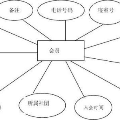This paper discusses the representation of ontologies in the first-order logical environment {\ttfamily FOLE}. An ontology defines the primitives with which to model the knowledge resources for a community of discourse. These primitives consist of classes, relationships and properties. An ontology uses formal axioms to constrain the interpretation of these primitives. In short, an ontology specifies a logical theory. This paper continues the discussion of the representation and interpretation of ontologies in the first-order logical environment {\ttfamily FOLE}. The formalism and semantics of (many-sorted) first-order logic can be developed in both a \emph{classification form} and an \emph{interpretation form}. Two papers, the current paper, defining the concept of a structure, and ``The {\ttfamily ERA} of {\ttfamily FOLE}: Superstructure'', defining the concept of a sound logic, represent the \emph{classification form}, corresponding to ideas discussed in the ``Information Flow Framework''. Two papers, ``The {\ttfamily FOLE} Table'', defining the concept of a relational table, and ``The {\ttfamily FOLE} Database'', defining the concept of a relational database, represent the \emph{interpretation form}, expanding on material found in the paper ``Database Semantics''. Although the classification form follows the entity-relationship-attribute data model of Chen, the interpretation form incorporates the relational data model of Codd. A fifth paper ``{\ttfamily FOLE} Equivalence'' proves that the classification form is equivalent to the interpretation form. In general, the {\ttfamily FOLE} representation uses a conceptual structures approach, that is completely compatible with the theory of institutions, formal concept analysis and information flow.
翻译:本文讨论本体在一阶逻辑环境 FOE 中的表示。本体定义了用于模拟历史语境下的知识资源的基本概念。这些基本概念由类,关系和属性组成,利用形式化公理来约束这些基本概念的解释。简而言之,本体规定了一个逻辑理论。本文继续讨论在一阶命题逻辑环境 FOE 中的本体的表示和解释。多元一阶逻辑的形式、语义都可以在“分类形式”和“解释形式”下进行。这篇文章和“FOLE 时代:上结构”的一个论文,后者定义了“结构”的概念,都代表了“分类形式”,相应的想法都在“信息流框架”的讨论中提出。而“FOLE 表”和“FOLE 数据库”则代表了“解释形式”,扩展了《数据库语义学》一书中的材料。虽然分类形式遵循 Chen 的实体关系属性数据模型,但解释形式则融合了 Codd 的关系数据模型。第五篇论文“FOLE 等价”证明了分类形式与解释形式是等价的。总体来说,FOLE 的表示方式采用了一个概念结构方法,这与机构理论、形式概念分析和信息流理论完全兼容。

